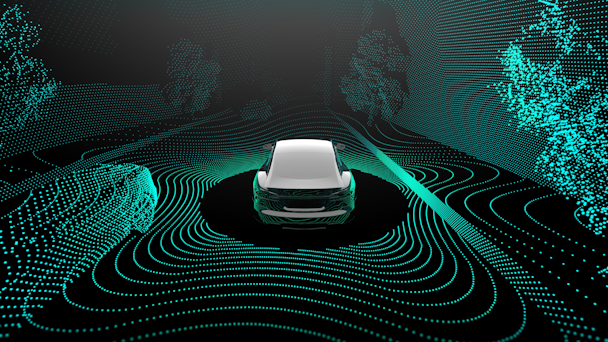‘A whole new world is emerging’: Predictions for the near future of AI
The rise of AI, like that of any transformational new technology, is likely to be a double-edged sword. Here’s NYU professor Vasant Dhar’s take on the near-term social impacts of intelligent machines.

They’re fairly rare today, but autonomous vehicles could become the norm sooner than you might think. / Adobe Stock
Artificial intelligence (AI) has moved upstream rapidly in the last year. Machines can now see, read and hear well, and they’re improving by the day. As a result, machines can interact with the world in ways that have until now been exclusive to humans. AI systems that perceive the world will enable many low-risk applications in the near future that are currently performed by humans at a high cost – or that are not manually possible at all.
Let’s start with vision. In the near future, AI systems will automatically analyze things like vehicle plates, faces, transportation patterns and much more. They will replace antiquated systems that rely on clunky hardware, humans or government agencies for administration.
How about autonomous vehicles (AVs)? Advancements in technologies such as 5G and the cloud will make AVs a reality, but this will happen in stages. I predict that we will see autonomous trucks followed by taxis before we see driverless cars in the wild. They are less risky because we can restrict them to specific routes that are well-tested.
Advertisement
Moving forward with caution
We don’t trust machines with driving us around in the wild because of the worst-case consequences of mistakes – I highlighted this point in my TEDx talk five years ago. At the moment, AVs still go off-course and hit people. They still make errors that we can’t understand and correct. Imagine a driverless car hitting a bunch of kids by mistake. I question Elon Musk’s assumption that we choose technologies that do the best for the most number of people. This assumption ignores the possible worst-case consequences that we have not envisioned or experienced.
Regardless of how many lives the technology will save on aggregate by replacing humans, the uncertainty about worst-case errors is a major hurdle to its widespread adoption. That’s why we still trust humans more than we trust even the most advanced AI on driverless cars. The cost of error is much too high, which is why insurance companies have yet to involve themselves with the AV field.
Remote operation by humans isn’t currently possible because the latency is still too high. When an operator in a control center turns or slams on the brake, the vehicle must respond immediately, with a sub-10 millisecond delay. When 5G becomes fast enough, I predict we will begin to see remotely operated vehicles on the road. Regulators will consider remote human operators to be a lower-risk option than fully autonomous vehicles. Equally importantly, this transition will generate important data for improving autonomous driving in the wild.
AI systems will also liberate human attention. There are only so many things we can attend to during the course of a day, which makes attention a valuable human resource. AI models such as ChatGPT3 - or conversational AI more generally - will expand our attention by proofreading, summarizing, and creating documents at lightning speed compared to humans, freeing us up to accomplish other tasks. Generative AI will create customized marketing pitches automatically using existing documents, videos or other sources of data. On the operations front, AI will support customers through a natural dialog that simulates human operators, reducing the need for humans in such roles.
Advertisement
Machine marketing
At the same time, AI systems will also attract human attention by blending marketing and entertainment, the way TikTok is already doing. Intelligent machines will continue to improve on this front, generating more and more data as it interacts with more and more people more and more often; it’s the ultimate in one-to-one marketing. Indeed, generative AI could automatically create new kinds of materials – images, videos and stories – tailored for particular individuals and groups. Generally speaking, expensive human talent will be replaced by low-cost machines.
A whole new world is emerging much faster than we had anticipated even a year ago. AI will have a major boost on productivity, but in the process, it will displace large numbers of humans whose jobs rely on their perceptive or intellectual abilities. This will raise the bar considerably for human employment going forward.
Vasant Dhar is a professor of technology, operations and statistics at the New York University Stern School of Business. For more on the latest happening in tech, sign up for The Drum’s Inside the Metaverse weekly newsletter here.
